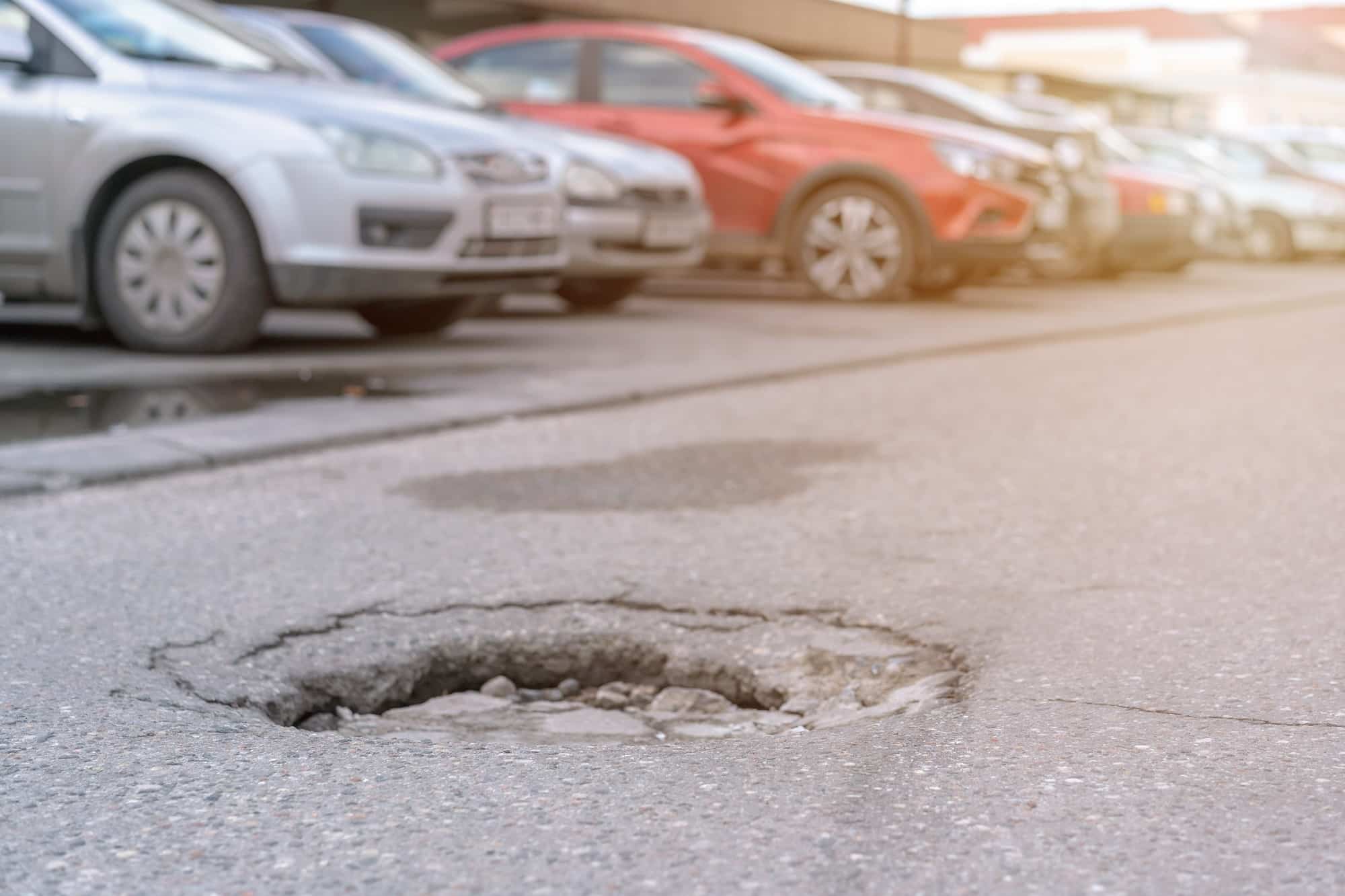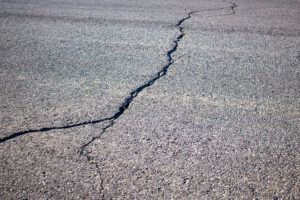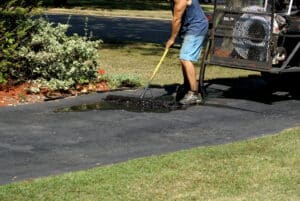The parking lot is an extension of its venue. Having access to parking spaces is both a blessing and a responsibility. On one hand, your staff and customers can drive right up to the business. On the other, you are also responsible for maintaining the safety and appearance of your business’s parking lot. While it may seem like parking lots are eternal and will last forever, they do not. All pavement wears down with time and traffic, and the durability of a parking lot depends heavily on the stability of the sub-base below the asphalt.
Pavement ages over time. It often benefits from fresh sealcoat and occasional resurfacing in addition to spot-fixing cracks and pits. To keep your company’s parking lot as safe and welcoming as possible, the best approach is a regular pavement inspection and promptly scheduled parking lot repair services when damage becomes noticeable. The sooner you seal a crack, the shorter the distance it can spread.
Why invest in parking lot repair?
The benefits of a well-maintained parking lot fall into three categories: Safety, Curb Appeal, and Logistics. When your parking lot is damaged, it is no longer as safe to walk or drive over. Timely repairs are the best way to keep your pavement areas safe and minimize further damage.
Safety
The safest pavement is smooth and recently sealcoated. This provides a sealed and even surface for vehicles and pedestrians. Cracks, pits, and exposed gravel medium reduce that safety and increase the chance of an accident or injury. The faster you repair your pavement, the less damage is done and the less risk is created.
Curb Appeal
A well-maintained parking lot speaks highly of the business it parks for. You want your parking lot to look safe, welcoming, and comfortable for your clients. It should also look neat and professional from the road. The quality of your parking lot can influence your property value, curb appeal, and the general trustworthy impression of your business. Smooth and recently painted pavement shows a business’ best side to those who park and drive by.
Logistics
Maintaining your parking lot saves time and money in a number of small ways. Rapid repairs prevent extensive damage later. An even driving surface can improve the flow of clients, employees, and delivery trucks through your lot driveways. Avoid the slow-downs and minor vehicle damage caused by broad cracks and uneven pavement surfaces.
Commercial Parking Lot Repair Methods
- Asphalt Patching
- Crack Sealing
- Sealcoating
- Asphalt Resurfacing
- Asphalt Overlay
- Pavement Removal and Replacement
Common Asphalt Repairs to Identify in Your Parking Lot
Know what to look out for when surveying your parking lot. Most asphalt pavement issues are common and therefore easily spotted when they appear. Each pavement issue has one or more solutions that can be used to repair the damage and return your parking lot to its smooth and professional state. Here are the primary causes for parking lot repair calls and what to look out for:
Potholes
Potholes are the easiest problem to spot and are a result of water expanding and receding below the pavement. When rainwater gets into the subbase underneath the asphalt, the water can rise, pushing up the asphalt above it, then empty leaving that section to sink. This asphalt then breaks up with use and traffic, causing an unsightly hole. Potholes are dangerous and some are deep and sharp enough to break wheel axles. They create a risk of trip-and-fall injuries and damage to vehicles, which could cause potential liabilities.
Repairing a pothole usually requires a fresh patch of new asphalt. The pothole is first filled in with a more stable subbase and compacted, then fresh asphalt is poured over the top and compacted until it matches the level of your pavement once more.
Read More: Pothole Repair: Why It’s Needed and How It Works
Depressions
Depressions occur when the subbase below your asphalt collapses from moisture or weight. These depressions form low spots in the pavement that collect water and can become extremely dangerous for pedestrians. Depressions are a minor annoyance for drivers but they can form ice pits, potholes, dangerous puddles, and uneven surfaces.
The correct repair for depressions depends on the cause and your desire for speed. Often, the subbase has failed so the area of asphalt will need to be removed, re-based, and then re-poured. Fortunately, this maneuver can be used for one limited section of your pavement.
Pavement Cracks
Cracks in asphalt pavement occur for a number of reasons. Often, it is a disturbance in the subbase. Long and slab-shaped cracks could mean there is a concrete subbase below, expanding and contracting with the weather. Short and sharp cracks often indicate an incomplete pothole swell. Fortunately, cracks can often be resolved with sealant.
The fastest and most efficient way to fix asphalt cracks is with a crack sealant. This rubberized solution fills in cracks with a flexible sealant that prevents them from spreading any further. Cracks can also be shaved down and resurfaced starting below the level where the crack began to form.
Read More: Asphalt Crack Repair 101 for Property Managers
Alligator Cracking
Alligator cracks are often found within depressions. These cracks are an angular grid-like pattern resembling the scales of an alligator. This is the type of cracking you see when the subbase flexes and the pavement breaks into a shatter pattern as a result of that flex.
Alligator cracks can be crack sealed as a short-term method of slowing the damage but are best repaired by replacing the pavement and often the sub-base underneath. The entire area can be scooped clear and new pavement poured that will be more durable and withstand the weight or rain conditions your lot is subject to.
Surface Pitting and Gravel
Asphalt should be treated with sealcoating about once every three years. You can quickly identify a parking lot that hasn’t been sealed because the medium will start to show. The gravel used in the asphalt mix will start to chip away and the asphalt will start to appear pitted. This raveling or pitting process is also accelerated by the annual use of de-icer and seasonal ice melt in snowy regions.
Sealing your asphalt is the best way to keep that surface smooth and free of pitting and raveling. When seal coat is applied, the asphalt medium will be sealed in and much of the surface wear will be absorbed by the sealant. Sealcoat can be scheduled as a regular 3-year service and creates a regular opportunity to take care of any lingering parking lot repair needs as well.
Illegible Markings
Finally, parking lots must be kept painted to be useful. In fact, large enough businesses are required to have parking lot markings that adhere to certain regulations about disability spots and spacing.
If your parking lot paint has become illegible, this is a good sign that you also likely need parking lot repairs. Survey your lot for those lurking cracks and depressions. Then use your repairs as an opportunity to also repaint the surface for function and beauty.
Read More: Parking Lot Restriping: 8 Things Property Managers Should Know
Building a Pavement Maintenance Plan for Your Business
The best way to address commercial parking lot repair is with a regular pavement maintenance plan. Start with your re-sealing appointment every three years. Include the parking lot in your annual safety audit. If you have a snowy winter season, arrange for plowing and de-icing services as part of your parking lot maintenance plan.
When your inspections do reveal pavement damage, take swift action in scheduling parking lot repair services. The sooner a crack is sealed or a depression is filled, the less damage it can do to the nearby lot. Here at Superior Asphalt, LC, we understand the pavement needs of modern businesses. Contact us today to consult on repairing your parking lot or building a long-term parking lot maintenance plan.
More Resources for Property Managers:




